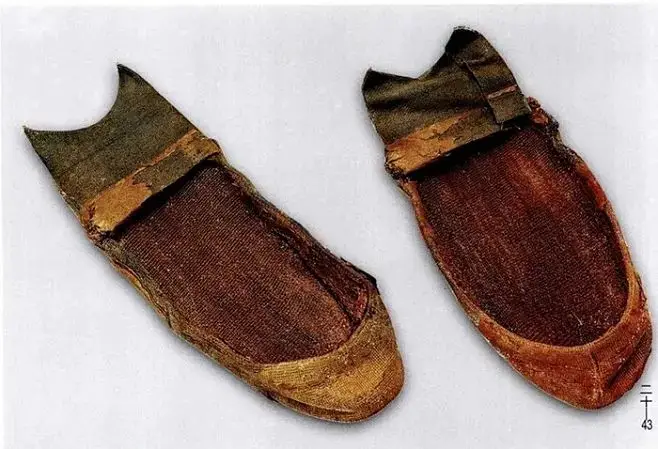白舄 (Báixí) is a distinctive type of footwear in ancient China, known for its color and material. In ancient times, white shoes were considered a symbol of nobility and were exclusively worn by individuals of specific social status. Here is a detailed exploration of white shoes:
Historical Background of White Shoes
White shoes have a long history in China, dating back to the Shang and Zhou periods. During this time, white shoes were reserved for aristocrats and officials, symbolizing their identity and status. Over time, white shoes evolved into ceremonial footwear used for rituals and important occasions. In ancient times, white shoes were crafted from silk, satin, or leather, making them relatively expensive and inaccessible to the common people.
Symbolic Meaning of White Shoes
1. Prestige and Status: In ancient China, white shoes symbolized prestige and social status. Only the emperor, empress, crown prince, nobility, and high-ranking officials were permitted to wear white shoes. Wearing white shoes during ceremonies expressed respect for deities and ancestors.

2. Purity and Elegance: The color white often represents purity and elegance in Chinese culture. Therefore, white shoes are considered a symbol of refinement, and those who wear them are thought to possess noble virtues and refined sentiments.
3. Rituals and Norms: White shoes, as ceremonial footwear, required adherence to specific norms and etiquette during wear. In ancient times, wearing the wrong shoes was considered disrespectful, emphasizing the importance of adhering to the regulations and rituals associated with white shoes.
Cultural Significance of White Shoes
1. Art and Aesthetics: The creation of white shoes emphasizes artistry and aesthetics. The design, material, and patterns reflect the exquisite craftsmanship and aesthetic concepts of ancient artisans. White shoes are an integral part of ancient clothing culture, contributing significantly to the study of ancient art and aesthetics.
2. Social and Political Connection: As a representative of traditional clothing, white shoes have a close connection to social and political aspects. In ancient times, attire served as a symbol of identity and status, with different clothing distinguishing various social classes and ranks. Therefore, the use and regulations surrounding white shoes reflected the hierarchical and political structure of ancient society.
3. Tradition and Customs: White shoes, as one of China’s traditional footwear, carry numerous traditions and customs. In ancient times, there were regulations and customs regarding the style, material, and wearing of shoes. These traditions reflect the social customs and cultural characteristics of ancient society.
Modern White Shoe Culture
In contemporary society, with changing times and societal developments, white shoes are no longer a necessity in daily life. However, on special occasions and cultural events, people may still wear traditional white shoes to express respect for and continuation of traditional culture. Additionally, some individuals may collect white shoes as artifacts or art pieces for appreciation.
Preserving and Developing White Shoe Culture
To preserve and develop white shoe culture, efforts can be made in the following areas:
1. Protection and Collection: Traditional white shoes with historical and artistic value should be protected and collected. Museums, libraries, and cultural institutions can play a role in collecting and exhibiting white shoes, allowing more people to understand and appreciate this cultural phenomenon.
2. Heritage and Innovation: While preserving traditional white shoes, there should also be a focus on innovation and development. Designing and producing white shoes that align with modern aesthetic preferences and practical needs can help more people accept and appreciate this traditional footwear. Additionally, integrating traditional white shoe elements into modern clothing can promote a fusion of traditional and contemporary styles.
3. Education and Promotion: Through education and promotional activities, awareness and understanding of traditional white shoe culture can be increased. Educational and promotional events held in schools, communities, and other settings can introduce knowledge about the history, cultural significance, and craftsmanship of white shoes, fostering a sense of identity and pride in traditional culture.
4. International Exchange and Cooperation: By engaging in international exchanges and cooperation, Chinese white shoe culture can be showcased on the global stage. Collaborating with cultural institutions and museums in other countries can facilitate cultural exchange and mutual learning.
5. Academic Research and Publishing: Strengthening academic research and publishing works related to white shoe culture can contribute to its in-depth study and development. Organizing scholars and experts to conduct comprehensive research on the history, cultural significance, and craftsmanship of white shoes can provide theoretical support and practical guidance for the preservation and development of white shoe culture.
In conclusion, preserving and developing white shoe culture is essential for promoting outstanding traditional Chinese culture, fostering international cultural exchange, and enriching people’s spiritual and cultural lives. Through various approaches and methods, dedicated efforts can protect, inherit, and innovate white shoe culture, allowing this unique cultural heritage to shine brightly in the new era.